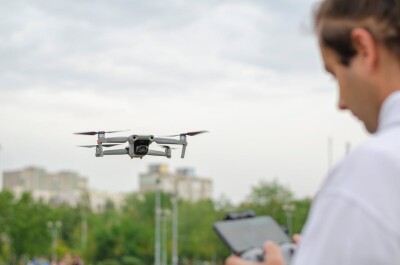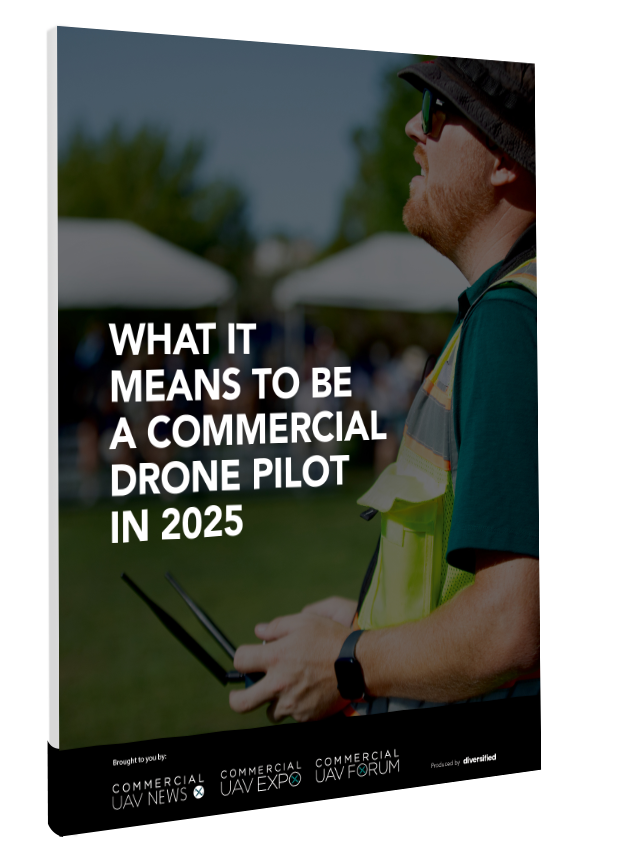From the quality of the presenters to the amazing new products and services that were on full display, the Commercial UAV Expo in Las Vegas exceeded my expectations in every respect. There were a number of things that stuck with me about the industry and the technology, and I was able to put together a few especially relevant items which should help us keep track of what’s happening in the present in the industry to have a better understanding of the future.
To see more from the Expo, check out our complete coverage from the event. Young Entrepreneurs are Making a Name for ThemselvesThe excitement of this new generation of entrepreneurs has really impressed me. These are the people have decided to make the drone industry part of their lives in a very significant way. They are from all over the world but share a passion for technology, engineering and innovation.Attacking old problems with new approaches and fresh attitudes is one of their common traits. So many of them are looking for and finding unorthodox solutions that use fresh concepts in a constantly connected environment, and their innovations are accelerating exponentially.One example is Damon Henry, 28 years old and CEO of Asylon, aerospace engineer from MIT who, with three colleagues from the same institution, decided to find a workaround for the limitation of flying time due to battery restrictions.Another is Jonathan Hesselbarth from Germany, founding member of Wingcopter and the lead engineer behind the amazing aircraft that transitions from vertical to horizontal flight seamlessly in seconds; a problem that has been baffling experts for decades.What’s happening today with the UAV industry can only be compared to the excitement of the 80s with the then nascent computer industry. Young entrepreneurs such as Bill Gates and Steve Jobs were creating new devices in their garages and starting companies from zero with just a great idea and some borrowed capital. Sounds familiar?I firmly believe we are witnessing the next big revolution in human communication and transportation. This generation of young entrepreneurs really is the tip of this fast moving spear.It would take too many pages to list all of the companies that had something especially exciting and revolutionary to show off, but you can easily see the list of exhibitors to find out who are the leading companies in this space and learn more about where the future of this industry is heading.
Young Entrepreneurs are Making a Name for ThemselvesThe excitement of this new generation of entrepreneurs has really impressed me. These are the people have decided to make the drone industry part of their lives in a very significant way. They are from all over the world but share a passion for technology, engineering and innovation.Attacking old problems with new approaches and fresh attitudes is one of their common traits. So many of them are looking for and finding unorthodox solutions that use fresh concepts in a constantly connected environment, and their innovations are accelerating exponentially.One example is Damon Henry, 28 years old and CEO of Asylon, aerospace engineer from MIT who, with three colleagues from the same institution, decided to find a workaround for the limitation of flying time due to battery restrictions.Another is Jonathan Hesselbarth from Germany, founding member of Wingcopter and the lead engineer behind the amazing aircraft that transitions from vertical to horizontal flight seamlessly in seconds; a problem that has been baffling experts for decades.What’s happening today with the UAV industry can only be compared to the excitement of the 80s with the then nascent computer industry. Young entrepreneurs such as Bill Gates and Steve Jobs were creating new devices in their garages and starting companies from zero with just a great idea and some borrowed capital. Sounds familiar?I firmly believe we are witnessing the next big revolution in human communication and transportation. This generation of young entrepreneurs really is the tip of this fast moving spear.It would take too many pages to list all of the companies that had something especially exciting and revolutionary to show off, but you can easily see the list of exhibitors to find out who are the leading companies in this space and learn more about where the future of this industry is heading.  Part 107 has had a Major Impact on the IndustryThe Commercial UAV Expo was one of the first commercial UAV shows to be held after the release of Part 107 by the FAA on August 29, and the immediate impact that this ruling is having across the industry was palpable at the event. A large percentage of the people attending the show had already received their licenses while plenty other had either applied or were in the process of completing the test.What Part 107 brought to our industry in abundance is legitimacy. The feel on the floor of the conference is that drones are here to stay and now we have clear guidelines from the federal government to move forward and find new ways, under the law, to do our jobs better, faster, and at lower costs with less pollution. This ruling by the FAA will be a catalyst to our industry and will mark the beginning of an era in which more and more drones will enter our daily life in an orderly fashion and in full compliance with the laws that rule our shared airspace.Exactly what this looked like was a topic of conversation in many sessions and panels, and the truth is we don’t have all that many answers about specifics right now. However, there is a path in a way that didn’t really exist previously, and it’s one a lot of people are excited about.
Part 107 has had a Major Impact on the IndustryThe Commercial UAV Expo was one of the first commercial UAV shows to be held after the release of Part 107 by the FAA on August 29, and the immediate impact that this ruling is having across the industry was palpable at the event. A large percentage of the people attending the show had already received their licenses while plenty other had either applied or were in the process of completing the test.What Part 107 brought to our industry in abundance is legitimacy. The feel on the floor of the conference is that drones are here to stay and now we have clear guidelines from the federal government to move forward and find new ways, under the law, to do our jobs better, faster, and at lower costs with less pollution. This ruling by the FAA will be a catalyst to our industry and will mark the beginning of an era in which more and more drones will enter our daily life in an orderly fashion and in full compliance with the laws that rule our shared airspace.Exactly what this looked like was a topic of conversation in many sessions and panels, and the truth is we don’t have all that many answers about specifics right now. However, there is a path in a way that didn’t really exist previously, and it’s one a lot of people are excited about.  Big Players are Entering the ArenaCompanies like Intel and Airbus were present at the Commercial UAV Expo, and their presence brought a hint of things to come. The beginnings of every industry is marked by the sudden creation of many small startups that bring new solutions and new products to the market, but consolidation is inevitable. Large corporations will play a key role when the technology reaches maturity.Intel’s strategic move to acquire Ascending Technologies and to create products specifically targeted at the drone industry is a clear indication of the immediate revenue potential of this new technology. Airbus currently has a large portfolio of unmanned vehicles for military use, but their big presence at the event along with their recent investment in R&D signals a strategic decision to focus on the commercial space.Companies of all sizes have and will continue to see what kind of opportunities are presented by the technology, but seeing these big names and these big commitments is a sign of what the future has in store for them and for all of us.
Big Players are Entering the ArenaCompanies like Intel and Airbus were present at the Commercial UAV Expo, and their presence brought a hint of things to come. The beginnings of every industry is marked by the sudden creation of many small startups that bring new solutions and new products to the market, but consolidation is inevitable. Large corporations will play a key role when the technology reaches maturity.Intel’s strategic move to acquire Ascending Technologies and to create products specifically targeted at the drone industry is a clear indication of the immediate revenue potential of this new technology. Airbus currently has a large portfolio of unmanned vehicles for military use, but their big presence at the event along with their recent investment in R&D signals a strategic decision to focus on the commercial space.Companies of all sizes have and will continue to see what kind of opportunities are presented by the technology, but seeing these big names and these big commitments is a sign of what the future has in store for them and for all of us.  LIDAR Technology has Become Smaller and More AffordableI was pleasantly surprised at the new product releases from RIEGL, Velodyne and Phoenix Aerial Systems in which surveying-grade LIDAR units are now smaller and more affordable.With weights that go from 590 to 1,500 grams and provide scanning speeds of up to 100 scans/second, this ground-breaking mapping technology is now accessible and less cumbersome. These new products allow surveying professionals to enhance and augment their portfolios and conduct faster and more precise jobs.For a long while now, surveyors have understood the kind of advantages that drones possess, but because of logistics associated with weight and payload, they haven’t been able to use them the way they want. Those logistical limitations are being removed which means a whole new application of drone technology is being opened up before our eyes.
LIDAR Technology has Become Smaller and More AffordableI was pleasantly surprised at the new product releases from RIEGL, Velodyne and Phoenix Aerial Systems in which surveying-grade LIDAR units are now smaller and more affordable.With weights that go from 590 to 1,500 grams and provide scanning speeds of up to 100 scans/second, this ground-breaking mapping technology is now accessible and less cumbersome. These new products allow surveying professionals to enhance and augment their portfolios and conduct faster and more precise jobs.For a long while now, surveyors have understood the kind of advantages that drones possess, but because of logistics associated with weight and payload, they haven’t been able to use them the way they want. Those logistical limitations are being removed which means a whole new application of drone technology is being opened up before our eyes.  Collision Avoidance Systems and UTM are the FutureEven though Part 107 has opened up the sky in a very real manner, the constraint around having to operate within visual line of sight (VLOS) is a restriction that many see as still holding up development. Forcing operators to keep a constant view of the unmanned aircraft at all times is imposing a huge limitation in certain applications, especially when it comes to the size of the area that can be covered in one mission.One technology that will help the industry, and the regulators, is the collision avoidance system being developed by ingenious entrepreneurs. If the FAA ever lifts the VLOS restriction, there’s little doubt systems and capabilities that ensure the operator is aware, at all times, that the vehicle is not a danger to people and/or property will be essential. It’s the sort of technology that ensures a safe and expeditious return to land is possible in just about any circumstance.The more we can do to assure our unmanned vehicles are not a hazard, the better the chance of easing regulations and enhancing our ability to penetrate news areas of business. Sense and avoid capabilities along with the development of an unmanned aircraft systems traffic management (UTM) system will help ensure the airspace is and remains safe while also ensuring commercial development can proceed.
Collision Avoidance Systems and UTM are the FutureEven though Part 107 has opened up the sky in a very real manner, the constraint around having to operate within visual line of sight (VLOS) is a restriction that many see as still holding up development. Forcing operators to keep a constant view of the unmanned aircraft at all times is imposing a huge limitation in certain applications, especially when it comes to the size of the area that can be covered in one mission.One technology that will help the industry, and the regulators, is the collision avoidance system being developed by ingenious entrepreneurs. If the FAA ever lifts the VLOS restriction, there’s little doubt systems and capabilities that ensure the operator is aware, at all times, that the vehicle is not a danger to people and/or property will be essential. It’s the sort of technology that ensures a safe and expeditious return to land is possible in just about any circumstance.The more we can do to assure our unmanned vehicles are not a hazard, the better the chance of easing regulations and enhancing our ability to penetrate news areas of business. Sense and avoid capabilities along with the development of an unmanned aircraft systems traffic management (UTM) system will help ensure the airspace is and remains safe while also ensuring commercial development can proceed.  The innovators and innovations we saw this year at the Commercial UAV Expo prove that there are no limits in terms of what this technology can do, and we’re only at the beginning of what is set to be a true revolution in various markets including construction, surveying, mining, agriculture and plenty more.
The innovators and innovations we saw this year at the Commercial UAV Expo prove that there are no limits in terms of what this technology can do, and we’re only at the beginning of what is set to be a true revolution in various markets including construction, surveying, mining, agriculture and plenty more.















Comments